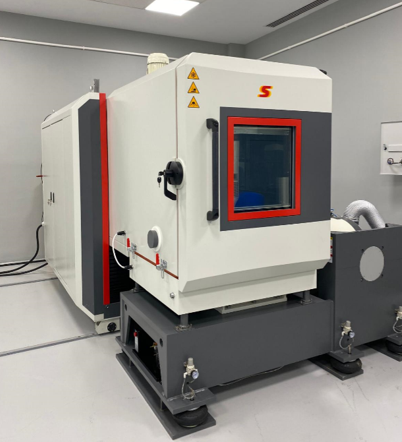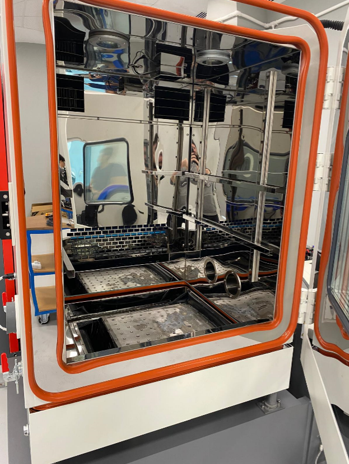Vibration Lab
Last Updated:
- English
- Türkçe
Vibration Laboratory
Our center is fully equipped with a wide range of devices, ready to perform all kinds of tests in the field of vibration.
Shakers
- Modal Type Shakers (30 N, 400 N, and 500 N capacity)
- Environmental Test Shakers (400 N, 3 kN, and 10 kN capacity)
In addition to low-force modal shakers, our center has the capability and expertise to conduct tests at varying force levels using medium-capacity (3 kN) and high-capacity (10 kN) shakers

Figure 1. Shaker
Conditioning Test Chamber
- A 600-liter conditioning chamber with a temperature range of -70°C to +150°C
- Temperature change (ramp) rates: 2, 5, 10, and 15°C/min
Configuration options:
- Temperature-only models
- Temperature and humidity combination models
At our center, expert professors and researchers conduct vibration and mechanical tests with the following capabilities:
Testing Capabilities
- General vibration measurements (velocity, acceleration, frequency analysis, RMS measurements, etc.)
- Modal vibration tests (natural frequency determination, frequency response function measurements, shaker tests, impact hammer tests, mode shapes and frequency determination)
- Environmental vibration and shock tests
- Sine sweep tests (according to MIL-STD-810 and similar standards)
- Resonance tests (according to MIL-STD-810 and similar standards)
- Random vibration tests (according to MIL-STD-810 and similar standards)
- Shock tests (according to MIL-STD-810 and similar standards)
- Lifetime tests with vibration input (in compliance with relevant standards)
- Cold and hot temperature tests (according to MIL-STD-810 and similar standards)

Figure 2. Conditioning Test Chamber

Figure 3. Inside of the Conditioning Test Chamber
Sensors
- Single-axis accelerometers
- Three-axis accelerometers
- Single-axis piezoelectric force sensors
- Three-axis piezoelectric force sensors
- Single-axis load cells
- Laser vibrometers
- Non-contact displacement sensors
- Contact displacement sensors
- Impact hammers
With a laser velocity sensor, displacement, velocity, and acceleration data can be obtained without altering the system dynamics of the tested/measured product. Currently, one laser velocity sensor is available, and the procurement process for additional units is ongoing.
Figure 4. Laser Accelerometer
Data Acquisition Systems
- Dewesoft (24-channel)
- LMS (8-channel)
- National Instruments USB-DAQ cards
- National Instruments PCI-DAQ cards
- Oscilloscope
References
- TAI
- ROKETSAN
- Türk Traktör
- ŞARA
- STM
- Korucu Makine
- ATEL
- Hünkar Ecza ve Medikal
